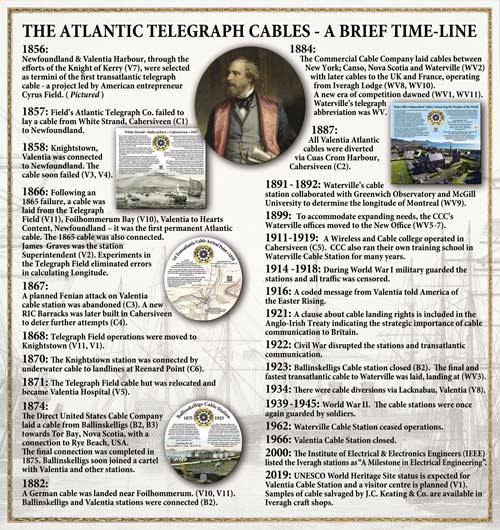The Atlantic Telegraph Cables - a Brief Time-Line
|
Click on the image for a larger view |
1856
Newfoundland & Valentia Harbour, through the efforts of the Knight of Kerry (V7), were selected as termini of the first transatlantic telegraph cable - a project led by American entrepreneur Cyrus Field.
1857
Field’s Atlantic Telegraph Co. failed to lay a cable from White Strand, Cahersiveen (C1) to Newfoundland.
1858
Knightstown, Valentia was connected to Newfoundland. The cable soon failed (V3, V4).
1866
Following an 1865 failure, a cable was laid from the Telegraph Field (V11), Foilhommerum Bay (V10), Valentia to Heart’s Content, Newfoundland – it was the first permanent Atlantic cable. The 1865 cable was also connected. James Graves was the station Superintendent (V2). Experiments in the Telegraph Field eliminated errors in calculating Longitude.
1867
A planned Fenian attack on Valentia cable station was abandoned (C3). A new RIC Barracks was later built in Cahersiveen to deter further attempts (C4).
1868
Telegraph Field operations were moved to Knightstown (V11, V1).
1870
The Knightstown station was connected by underwater cable to landlines at Reenard Point (C6).
1871
The Telegraph Field cable hut was relocated and became Valentia Hospital (V5).
1874
The Direct United States Cable Company laid a cable from Ballinskelligs (B2, B3) towards Tor Bay, Nova Scotia, with a connection to Rye Beach, USA. The final connection was completed in 1875. Ballinskelligs soon joined a cartel with Valentia and other stations.
1882
A German cable was landed near Foilhommerum. (V10, V11). Ballinskelligs and Valentia stations were connected (B2).
1884
The Commercial Cable Company laid cables between New York; Canso, Nova Scotia and Waterville (WV2) with later cables to the UK and France, operating from Iveragh Lodge (WV8, WV10). A new era of competition dawned (WV1, WV11). Waterville’s telegraph abbreviation was WV.
1887
All Valentia Atlantic cables were diverted via Cuas Crom Harbour, Cahersiveen (C2).
1891 - 1892
Waterville’s cable station collaborated with Greenwich Observatory and McGill University to determine the longitude of Montreal (WV9).
1899
To accommodate expanding needs, the CCC’s Waterville offices moved to the New Office (WV5-7).
1911-1919
A Wireless and Cable college operated in Cahersiveen (C5). CCC also ran their own training school in Waterville Cable Station for many years.
1914 -1918
During World War I military guarded the stations and all traffic was censored.
1916
A coded message from Valentia told America of the Easter Rising.
1921
A clause about cable landing rights was included in the Anglo-Irish Treaty, indicating the strategic importance of cable communication to Britain.
1922
Civil War disrupted the stations and transatlantic communication.
1923
Ballinskelligs Cable station closed (B2). The final and fastest transatlantic cable to Waterville was laid, landing at (WV3).
1934
There were cable diversions via Lacknabau, Valentia (V8).
1939 -1945
World War II. The cable stations were once again guarded by soldiers.
1962
Waterville Cable Station ceased operations.
1966
Valentia Cable Station closed.
2000
The Institute of Electrical & Electronics Engineers (IEEE) listed the Iveragh stations as “A Milestone in Electrical Engineering”.
2019
UNESCO World Heritage Site status is expected for Valentia Cable Station and a visitor centre is planned (V1).
Samples of cable salvaged by J.C. Keating & Co. are available in Iveragh craft shops.

